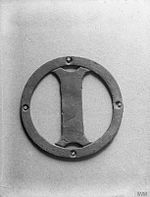Eight ships of the Royal Navy have been named HMS Intrepid:
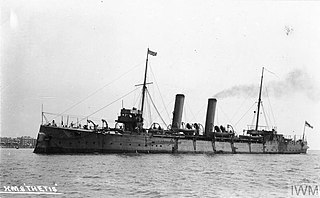
HMS Thetis was an Apollo-class 2nd class protected cruiser of the Royal Navy, launched on 13 December 1890. Her first significant mission was service in the Bering Sea Patrol with American warships in a combined effort to suppress poaching in the Bering Sea.
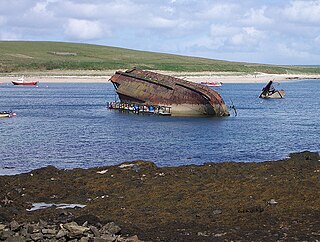
A blockship is a ship deliberately sunk to prevent a river, channel, or canal from being used as a waterway. It may either be sunk by a navy defending the waterway to prevent the ingress of attacking enemy forces, as in the case of HMS Hood at Portland Harbour in 1914; or it may be brought by enemy raiders and used to prevent the waterway from being used by the defending forces, as in the case of the three old cruisers HMS Thetis, Iphigenia and Intrepid scuttled during the Zeebrugge raid in 1918 to prevent the port from being used by the German navy.

The Zeebrugge Raid on 23 April 1918, was an attempt by the Royal Navy to block the Belgian port of Bruges-Zeebrugge. The British intended to sink obsolete ships in the canal entrance, to prevent German vessels from leaving port. The port was used by the Imperial German Navy as a base for U-boats and light shipping, which were a threat to Allied control of the English Channel and southern North Sea. Several attempts to close the Flanders ports by bombardment failed and Operation Hush, a 1917 plan to advance up the coast, proved abortive. As ship losses to U-boats increased, finding a way to close the ports became urgent and the Admiralty became more willing to consider a raid.

The Apollo class were second-class protected cruisers designed by Sir William White and built for the Royal Navy in the late 19th century. Twenty-one ships of this class were built, making it the largest single class of steel cruisers ever built for the Royal Navy to the same design.

HMS Afridi was a Tribal-class destroyer of the Royal Navy launched in 1907 and sold for scrap in 1919. During the First World War she served in the North Sea and the English Channel with the 6th Destroyer Flotilla and as part of the Dover Patrol.
HMS Faulknor was a British destroyer of the First World War. She was purchased by the Royal Navy whilst still under construction in Britain for the Chilean Navy who had ordered her in 1912 as part of the Almirante Lynch class. She was renamed after the Faulknor family of British nineteenth century naval officers.

HMS Brilliant was an Apollo-class cruiser of the British Royal Navy which served from 1893 to 1918 in various colonial posts and off the British Isles as a hastily converted minelayer during the First World War.

HMS Sirius was an Apollo-class cruiser of the British Royal Navy which served from 1892 to 1918 in various colonial posts such as the South and West African coastlines and off the British Isles as a hastily converted minelayer during the First World War.
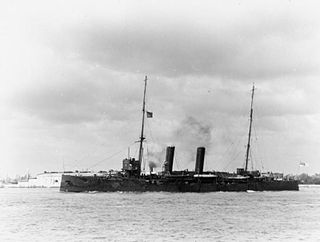
HMS Sappho was an Apollo-class cruiser of the British Royal Navy which served from 1892 to 1918 in various colonial posts.
Four ships of the Royal Navy have borne the name HMS Iphigenia, after Iphigenia, a figure in Greek mythology:

The Arrogant-class cruiser was a class of four protected cruisers built for the British Royal Navy at the end of the 1890s. One ship, HMS Gladiator, was lost following a collision with a merchant ship in 1908, while HMS Vindictive saw active service in the First World War, taking part in the Zeebrugge Raid in April 1918 before being sunk as a blockship during the Second Ostend Raid in May 1918.
HMS Murray was a Royal Navy Admiralty M-class destroyer. Ordered before the outbreak of war, she was therefore the first of her class to enter operation during the early months of the First World War. She was also the first vessel of the Royal Navy to carry the name HMS Murray.
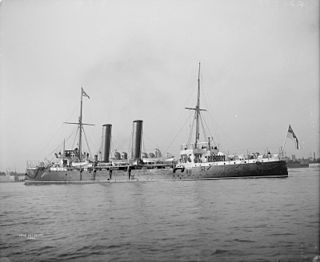
HMS Intrepid was an Apollo-class protected cruiser of the Royal Navy built on the River Clyde and launched in 1891. She was subsequently converted as a minelayer in the latter half of her career and ultimately sunk as a blockship during the Zeebrugge Raid on 23 April 1918.

HMS Speedy was a Alarm-class torpedo gunboat of the British Royal Navy. She was built by Thornycroft from 1892–1894. She was converted to a minesweeper in 1908–1909 and continued these duties during the First World War. Speedy was sunk by a German mine on 3 September 1914.

HMS Manly was a Yarrow M-class destroyer of the British Royal Navy. Built by the Scottish shipbuilder Yarrow between 1913 and 1914, Manly served during the First World War. She formed part of the Harwich Force in the early years of the war, and then later in the English Channel as part of the Dover Patrol taking part in the Zeebrugge Raid in 1918. She survived the war, and was sold for scrap in 1920.

HMS Landrail was a Laforey-class destroyer of the British Royal Navy. The Laforey class was the class of destroyers ordered under the Royal Navy's 1912–1913 construction programme, which were armed with three 4-inch (102 mm) guns and four torpedo tubes and were capable of 29 knots. The ship, which was originally to be named Hotspur but was renamed before launch, was built by the Scottish shipbuilder Yarrow between 1912 and 1914,

HMS Matchless was a Royal Navy Admiralty M-class destroyer. Matchless was built by Swan Hunter from 1913 to 1914 and was completed in December that year. She served through the remainder of the First World War, operating in the North Sea as part of the Harwich Force in the early part of the war and later in the English Channel as part of the Dover Patrol, where she took part in both the First and Second Ostend Raids. Despite being badly damaged by a German mine in 1915 and being involved in several collisions, she survived the war, and was sold for scrap in 1921.
HMS Melpomene was a Medea-class destroyer of the British Royal Navy. She was one of four destroyers, of similar design to the British M-class ordered by Greece in June 1914, which the British purchased during construction owing to the outbreak of the First World War.

HMS Morris was an Admiralty M-class destroyer which served with the Royal Navy during the First World War. The M class were an improvement on the preceding L class, capable of higher speed. The ship, the only vessel to be named Morris to serve with the Royal Navy, was launched on 19 November 1914. Joining the Grand Fleet as part of a new flotilla, the destroyer was soon in action, serving as part of a destroyer screen during the Battle of Dogger Bank in January 1915 and an escort to the minelayer Princess Margaret during a skirmish with German torpedo boats eight months later. At the Battle of Jutland in 1916, the destroyer was a crucial part of the flotilla that drove the German torpedo boats away from the British battlecruisers. Morris received no hits during these confrontations. The destroyer assisted in the rescue of survivors from the R-class destroyer Simoom and the recovery of the damaged flotilla leader Botha in 1917. The ship also undertook general duties including escorting merchant ships, minelayers, monitors, and the seaplane carrier Vindex. After the armistice that ended the war, the destroyer was considered superfluous to requirements, Initially placed in reserve, Morris was decommissioned and, on 8 November 1921, sold to be broken up.

